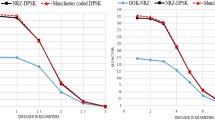Abstract
A 10 Gbps Continuous Phase Frequency Shift Keying (CPFSK) modulation is proposed for a Free Space Optical (FSO) communication system. The system performance is analyzed by considering effects of atmospheric conditions, beam divergence, transmitter and receiver antenna aperture diameters for 1550 nm operation. In this paper, we evaluate the system maximum Quality-factor (Q-factor), Bit Error Rate (BER), and received power, where the system is greatly affected by th e mentioned parameters. This simulation is performed by using the Optiwave system software. The obtained simulation results show that CPFSK modulated FSO system with low beam divergence and high aperture diameter is upgrading maximum Q-factor and degrading minimum BER.












Similar content being viewed by others
Data availability
The data used and/or analyzed during the current study are available from the corresponding author on reasonable request.
References
Abou-Rjeily, C.: On the optimality of the selection transmit diversity for MIMO-FSO links with feedback. IEEE Commun. Lett. 15, 641–643 (2011)
Abtahi, M., Lemieux, P., Mathlouthi, W., Rusch, L.A.: Suppression of turbulence-induced scintillation in free-space optical communication systems using saturated optical amplifiers. J. Lightwave Technol. 24(12), 4966–4973 (2006)
Abushagur, A.G., Abbou, F.M., Abdullah, M., Misran, N.: Performance analysis of free space terrestrial optical system in the presence of absorption, scattering and pointing error. J. Opt. Eng. 50, 075007 (2011)
Achour, M.: Simulating free space optical communication. Part, I.: Rain Fall Attenuation, Proc. SPIE 3635, (2002)
Arnon, S.: Optical wireless communications. In: Encyclopedia of Optical Engineering, 1 (2003)
Bloom, S., Korevaar, E., Schuster, J., Willebrand, H.: Understanding the performance of free-space optics. J. Opt. Netw. 2, 178–200 (2003)
Bushuev, D., Arnon, S.: Analysis of the performance of a wireless optical multi-input to multi-output communication system. J. Opt. Soc. Am. A23, 1722–1730 (2006)
Chowdhury, R., Sharoar Jahan Choyon, A.K.M.: Design of 320 gbps hybrid AMI-PDM-WDM FSO link and its performance comparison with traditional models under diverse weather conditions. J. Opt. Commun. (2021). https://doi.org/10.1515/joc-2020-0135
Fadhil, H.A., Amphawan, A., Shamsuddin, H.A.B., Abd, T.H., Al-Khafaji, H.M.R., Aljunid, S.A., Ahmed, N.: Optimization of free space optics parameters: an optimum solution for bad weather conditions. Optik 124, 3969–3973 (2013)
Ghassemlooy, Z., Popoola, W.O.: Terrestrial free-space optical communications. In: Fares, S.A., Adachi, F. (eds.) Mobile and Wireless Communications Network Layer and Circuit Level Design. InTech (2010)
Kim, I.I., McArthur, B., Korevaar, E.: Comparison of laser beam propagation at 785 nm and 1550 nm in fog and haze for optical wireless communications. Proc. SPIE 4214, 26–37 (2001)
Krishnan, P., Kumar, S.: Performance analysis of free-space optical systems employing binary polarization shift keying signaling over gamma-gamma channel with pointing errors. Opt. Eng. 53, 076105 (2014)
Liu, X.: Free-space optics optimization models for building sway and atmospheric interference using variable wavelength. Fiber Integr. Opt. 57, 492–498 (2009)
Mohammed, N.A., El-Wakeel, A.S., Aly, M.H.: Performance evaluation of FSO link under NRZ-RZ line codes, different weather conditions and receiver types in the presence of pointing errors. Open Electr. Electron. Eng. J. 6, 28–35 (2012)
Nadeem, F., Kvicera, V., Awan, M.S.: Weather effects on hybrid FSO/RF communication link. IEEE J. Sel. Area Commun. 27(9), 1687–1697 (2009)
Palanisamy, A.R., Tamilselvan, G.M., Pushparaghavan, A.: Design of high speed 10 Gb/s wired/FSO systems for local area communication networks for maximum reach. Photon Netw. Commun. 38(2), 206–218 (2019)
Prabu, K., Charanya, S., Jain, M., Guha, D.: BER analysis of SS-WDM based FSO system for Vellore weather conditions. Opt. Commun. 403, 73–80 (2017)
Prokes, A.: Atmospheric effects on availability of free space optics systems. J. Opt. Eng. 48, 066001 (2009)
Sinha, Shivaji, Kumar, C.: Performance analysis of a DPSK-based high-speed spectral-efficient FSO system under different weather conditions. J. Sci. Ind. Res. 82(6), 629–641 (2023)
Thakur, A., Nagpal, S., Gupta, A.: Kerr effect based spectrum sliced wavelength division multiplexing for free space optical communication. Optik 157, 31–37 (2018)
Tsiftsis, T.A., Sandalidis, H.G., Karagiannidis, G.K., Uysal, M.: Optical wireless links with spatial diversity over strong atmospheric turbulence channels. IEEE Trans. Commun. 8(2), 951–957 (2009)
Wang, J.Y., Wang, J.B., Chen, M., Huang, N., Jia, L.Q., Guan, R.: Ergodic capacity and outage capacity analysis for multiple-input single-output free-space optical communications over composite channels. Opt. Eng. 53, 016107 (2014)
Wang, Z., Zhong, W.-D., Fu, S., Lin, C.: Performance comparison of different modulation formats over free-space optical (FSO) turbulence links with space diversity reception technique. IEEE Photon. J 1(27), 277–285 (2009)
Funding
The authors did not receive any funds to support this research.
Author information
Authors and Affiliations
Contributions
A.R.P., K.C.R., J.R.J., R.M., P.R., and M.H.A. have directly participated in the planning, execution, and analysis of this study. All authors have read and approved the final version of the manuscript.
Corresponding authors
Ethics declarations
Conflict of interest
The authors declare that they have no competing interests.
Ethical approval
Not Applicable.
Additional information
Publisher’s Note
Springer Nature remains neutral with regard to jurisdictional claims in published maps and institutional affiliations.
Rights and permissions
Springer Nature or its licensor (e.g. a society or other partner) holds exclusive rights to this article under a publishing agreement with the author(s) or other rightsholder(s); author self-archiving of the accepted manuscript version of this article is solely governed by the terms of such publishing agreement and applicable law.
About this article
Cite this article
Palanisamy, A.R., Ramya, K.C., Jayasingh, J.R. et al. 10 Gbps CPFSK FSO system under various adverse atmospheric conditions: performance analysis. Opt Quant Electron 55, 911 (2023). https://doi.org/10.1007/s11082-023-05169-x
Received:
Accepted:
Published:
DOI: https://doi.org/10.1007/s11082-023-05169-x




